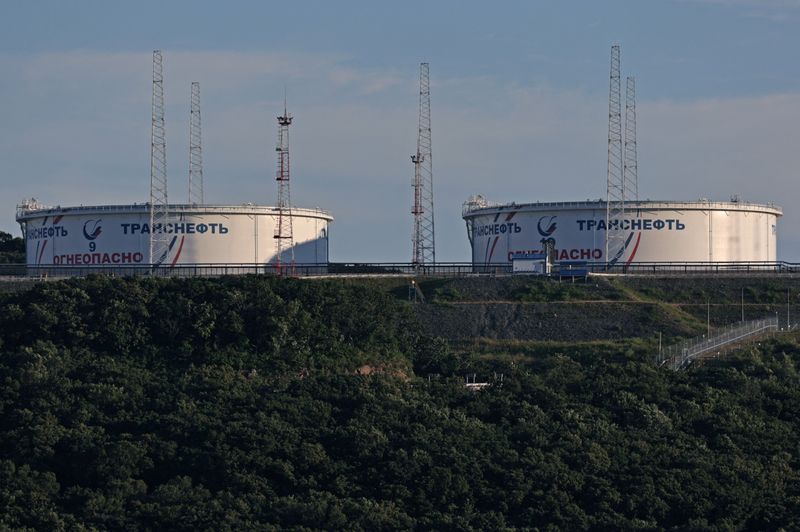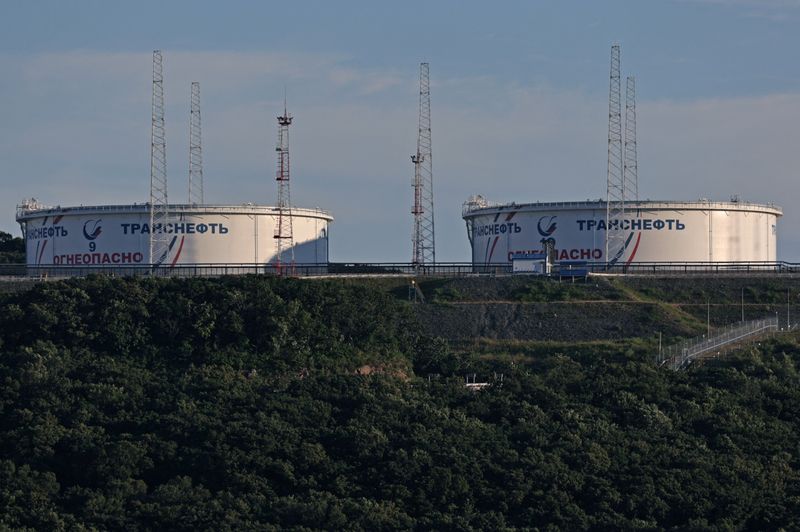Commodities
Oil climbs 2% on Mideast conflict and Libya outage


© Reuters. A view shows oil tanks of Transneft oil pipeline operator at the crude oil terminal Kozmino on the shore of Nakhodka Bay near the port city of Nakhodka, Russia August 12, 2022. REUTERS/Tatiana Meel/file photo
By Nicole Jao
NEW YORK (Reuters) -Oil prices climbed around 2% on Tuesday as the Middle East crisis and a Libyan supply outage pared the previous day’s heavy losses.
futures settled $1.47, or 1.9%, higher at $77.59 a barrel, while U.S. West Texas Intermediate crude (WTI) ended $1.47, or 2.1%, higher at $72.24.
Prices drew support from the closure of Libya’s 300,000 barrels per day (bpd) Sharara oilfield, one of its largest, which has been a frequent target for local and broader political protests, and Middle East tensions.
The Israeli military has said its fight against Hamas will continue through 2024, stoking concerns the conflict could escalate into a regional crisis that disrupts oil supplies.
Meanwhile, some major shipping companies are still avoiding the Red Sea following attacks by Iran-aligned Houthi militants in response to Israel’s war against Hamas. However, the impact on oil tanker movements has been less than expected, according to a Reuters analysis.
“The more attractive alternative for (oil tankers) right now is to make a dash for the United States, where is cheaper than Brent,” said Bob Yawger, director of energy futures at Mizuho.
Brent and WTI posted 3% and 4% losses respectively on Monday after sharp cuts to Saudi Arabia’s official selling prices (OSP), prompting both supply and demand concerns.
Oil futures also were also supported on Tuesday after Saudi Arabia emphasized its desire to support efforts to stabilize oil markets and following reports that Russia curbed its crude oil production level in December, said Price Futures Group analyst Phil Flynn.
“It’s an early sign of compliance by Russia,” he said.
Russia is part of the OPEC+ group of oil producers that has agreed to cut production by around 2.2 million bpd.
In the U.S., crude production will hit record highs over the next two years but grow at a slower rate, the Energy Information Administration (EIA) said, as efficiency gains offset a decline in rig activity. Output will rise by 290,000 bpd to a record 13.21 million bpd this year.
Crude stocks fell by 5.2 million barrels in the week ended Jan. 5, according to market sources citing American Petroleum Institute figures on Tuesday.[API/S]
Government data on stockpiles is due Wednesday. [EIA/S]
Core U.S. inflation data on Thursday will also be in the spotlight.
Commodities
Oil prices rise; U.S. crude inventories plunge, Russia-Ukraine truce eyed
Commodities
India’s Reliance to stop buying Venezuelan oil over US tariffs, sources say
Commodities
Oil prices climb on Venezuela supply worries

 Forex3 years ago
Forex3 years agoForex Today: the dollar is gaining strength amid gloomy sentiment at the start of the Fed’s week

 Forex3 years ago
Forex3 years agoUnbiased review of Pocket Option broker

 Forex3 years ago
Forex3 years agoDollar to pound sterling exchange rate today: Pound plummeted to its lowest since 1985

 Forex3 years ago
Forex3 years agoHow is the Australian dollar doing today?

 Cryptocurrency3 years ago
Cryptocurrency3 years agoWhat happened in the crypto market – current events today

 World3 years ago
World3 years agoWhy are modern video games an art form?

 Commodities3 years ago
Commodities3 years agoCopper continues to fall in price on expectations of lower demand in China

 Economy3 years ago
Economy3 years agoCrude oil tankers double in price due to EU anti-Russian sanctions

























